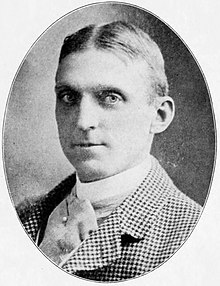George Cary (architect)
| George Cary | |
|---|---|

Cary in 1902
|
|
| Born | 1859 Buffalo, New York |
| Died | May 5, 1945 (aged 86) Buffalo, New York |
| Nationality | American |
| Alma mater |
Harvard College (1883) Columbia University L'Ecole des Beaux-Arts |
| Occupation | Architect |
| Spouse(s) | Allithea Birge (m. 1908; her death 1918) |
| Parent(s) | Walter Cary Julia Love |
George Cary (1859– May 5, 1945), was a major American architect from New York State known for his designs for the Pan American Exposition of 1901 in Buffalo, New York.
George Cary was born in 1859, the son of prominent Buffalo resident, Dr. Walter Cary (1818-1881) and Julia Cary (née Love). George was the grandson of Trumbull Cary (1787-1869), a New York State Senator and Assemblyman.
George was one of seven children: Trumbull Cary (1849-1913), Thomas Cary (1851-1921), Charles Cary (1852-1931), who in 1879 married Evelyn Rumsey (1855-1924), Jennie Cary (1854-1943), Walter Cary Jr. (1857-1933), George Cary (1859-1945), and Seward Cary (1862-1948). His nephew, Charles Cary Rumsey (1879–1922), through his sister Jennie and brother-in-law Laurence D. Rumsey (1849-1917), married Mary Harriman, daughter of millionaire railroad executive E. H. Harriman and Mary Williamson.
Cary attended and graduated from Harvard and the Columbia School of Architecture. After graduating from Columbia, Cary spent a brief apprenticeship with McKim, Mead and White in New York City. Directly after that, he went to Paris and studied at the Ecole des Beaux-Arts from 1886 until 1889, the first Buffalonian to do so.
In 1891, he returned to Buffalo and set up practice. In the mid-1890s, Cary redesigned some rooms in the Ansley Wilcox House, which later became known as Theodore Roosevelt Inaugural National Historic Site as it was the site where Theodore Roosevelt took the oath of office as President of the United States on September 14, 1901 after the assassination of William McKinley at the Pan-American Exposition of 1901.
...
Wikipedia
